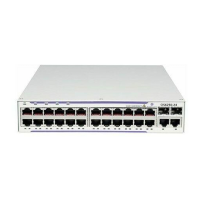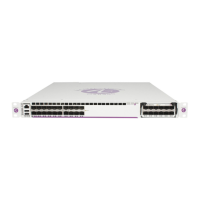Service Ingress QoS Policies
7210 SAS D, E, K OS Quality of Service Guide Page 221
Overview of service ingress policy on 7210 SAS-K
There is one default service ingress policy. The default policy allocates a single queue and maps all
traffic to the 'be' (best-effort) forwarding class. The default policies can be copied and modified
but they cannot be deleted. The default policies are identified as policy ID 1. The default policies
are applied to the appropriate interface, by default. For example, the default SAP ingress policy is
applied to access ingress SAPs. You must explicitly associate other QoS policies. For information
about the tasks and commands necessary to access the command line interface and to configure
and maintain your 7210 SAS devices, refer to the CLI Usage chapter in the 7210 SAS OS Basic
System Configuration Guide.
In a service ingress QoS policy, user can define up to 8 queues per policy, with up to 2 queues per
forwarding class. In the case of VPLS service, four types of forwarding are supported (which is
not to be confused with forwarding classes); unicast, multicast, broadcast, and unknown.
Multicast, broadcast, and unknown types are flooded to all destinations within the service while
the unicast forwarding type is handled in a point-to-point fashion within the service. All these
traffic types use the same queue (in other words, a separate queue for multicast, broadcast, and
unknown unicast traffic types cannot be defined). Unicast and multipoint traffic can be defined to
use the same queue or different queues per forwarding class. In other words, 8 queues are shared
by unicast and multicast traffic types and if user allocates a dedicated multicast queue for BUM
traffic, the number of queues available for unicast traffic reduces.
Configuration Guidelines for SAP ingress Policy for 7210 SAS-K
• User has an option to configure lesser number of ingress queues per SAP. In hardware
queues are allocated in groups of 2 and reserved for use by the SAP even though user
specifies an odd value.
• FC to queue map can be defined, this allows user to assign the packets classified into a
particular FC to any one of the queues configured for the SAP.
• Option is available to use up to 2 queues per FC, with one queue for Unicast traffic and
one queue for BUM traffic. BUM traffic shares a single queue per FC. In other words, it is
not possible to use individual queue for each of broadcast, unknown-unicast and multicast
traffic. It is possible to define the same queue for unicast and BUM traffic, if the user so
desires. For example, user can assign 2 queues per FC, such that unicast traffic uses one of
the queues and the BUM traffic uses the other queue. This allows users to have 4 FCs per
SAP with 2 queues per FC; OR user can have 7 FCs per SAP with 1 queue per FC and the
8th queue being shared by BUM traffic of all the FCs, OR a mix and match is allowed. If a
multicast queue is not assigned to a FC explicitly it uses queue 1 (the default queue of the
policy).
• The queue parameters such as queue shaper rate (CIR/PIR), cbs and mbs, queue priority
and weight can be defined. The assigned priority and weight is used to determine the
priority and weight of the queue in both the CIR and PIR scheduling loop.

